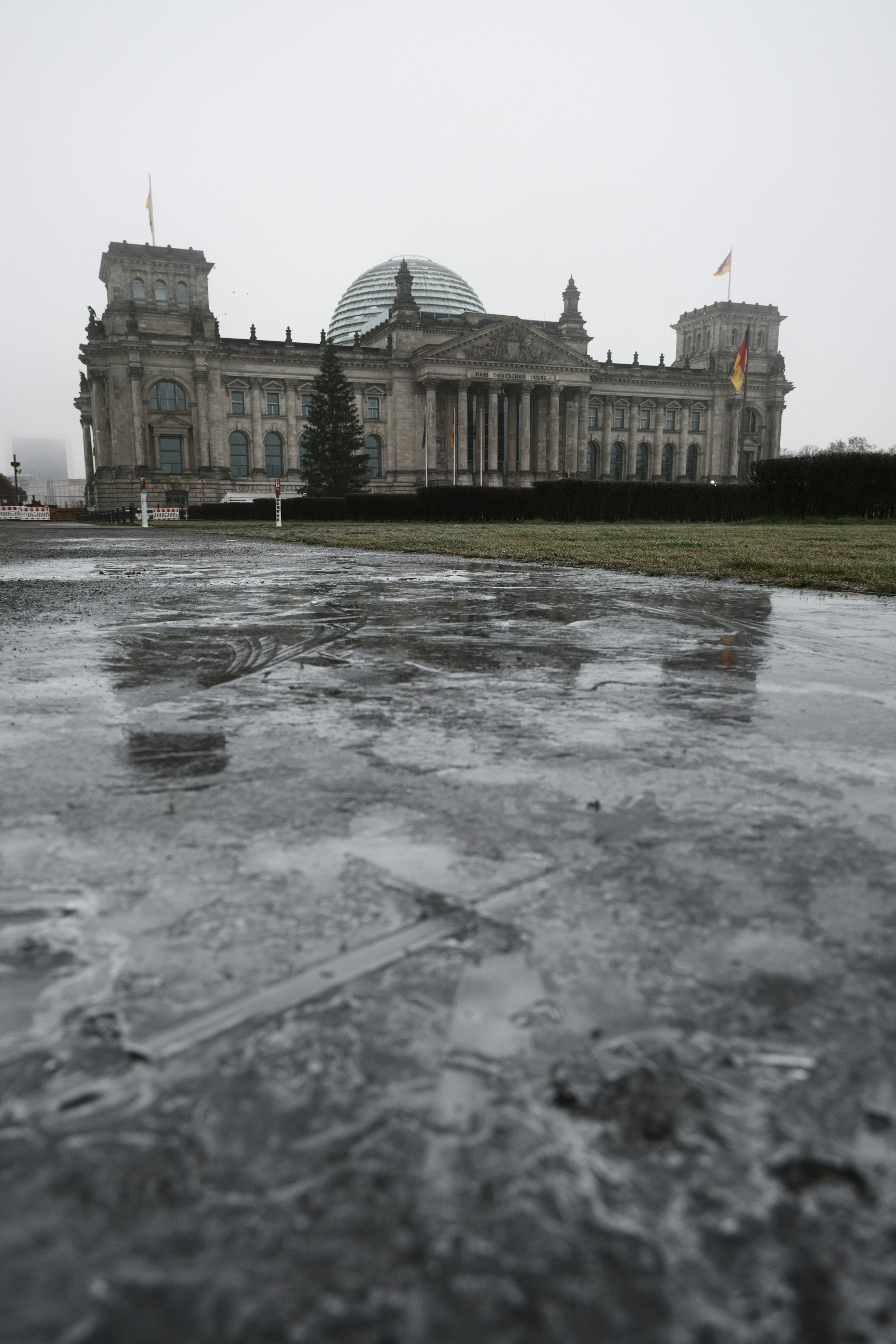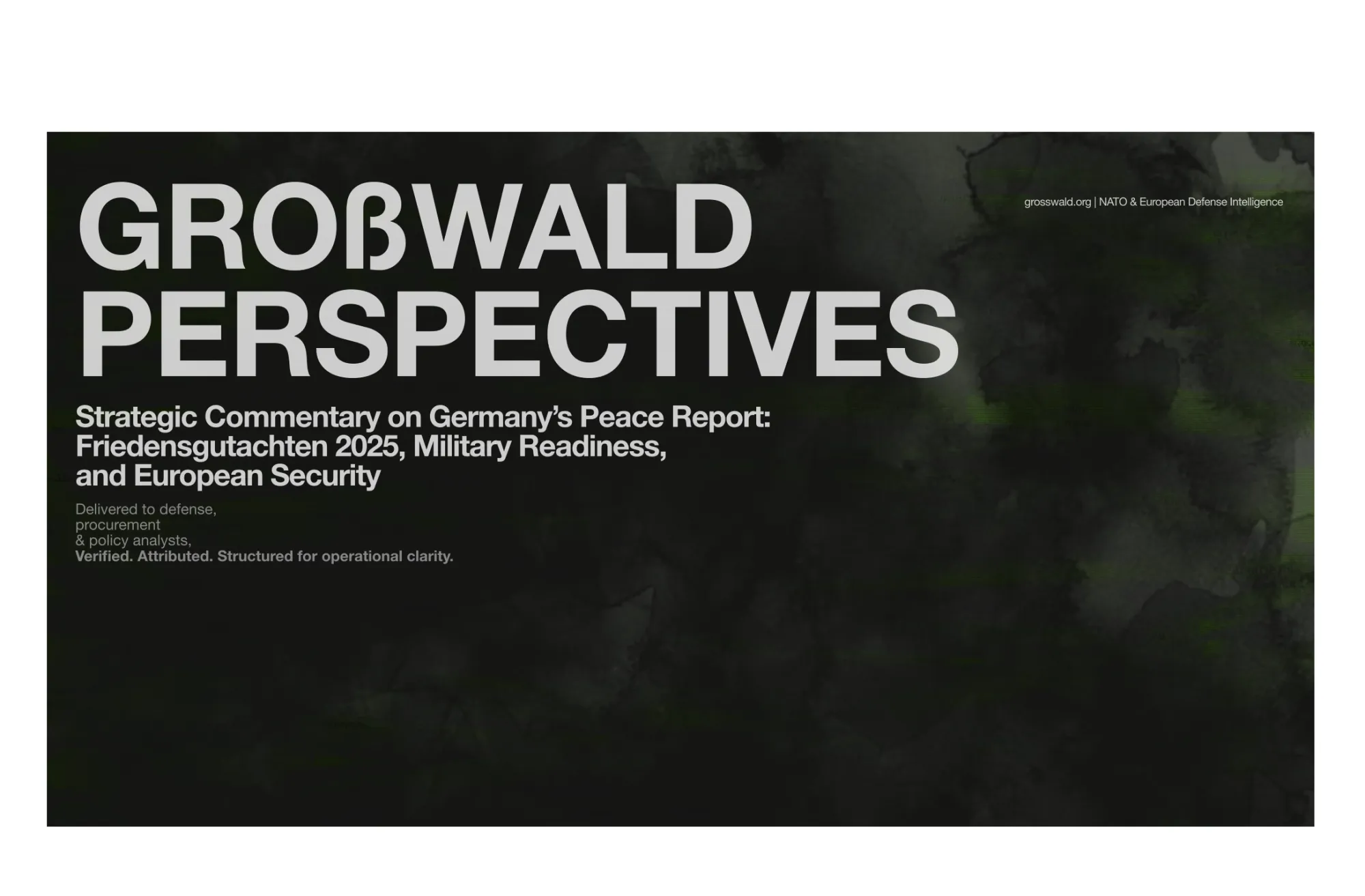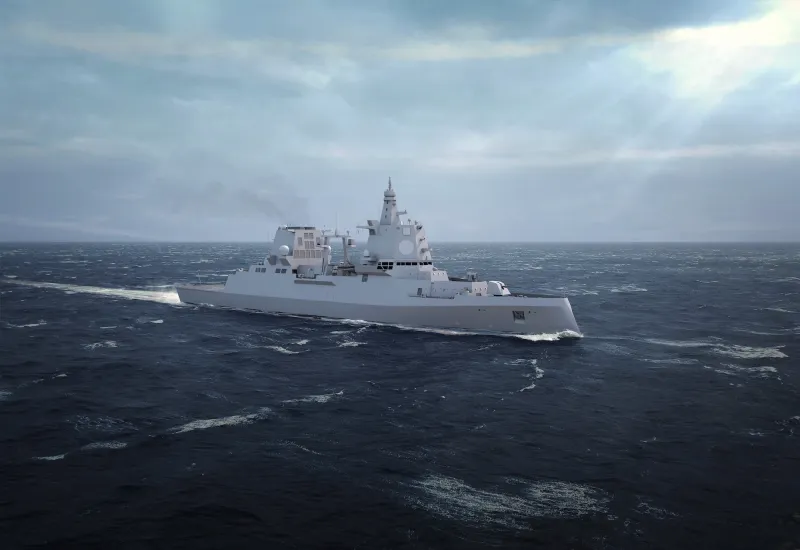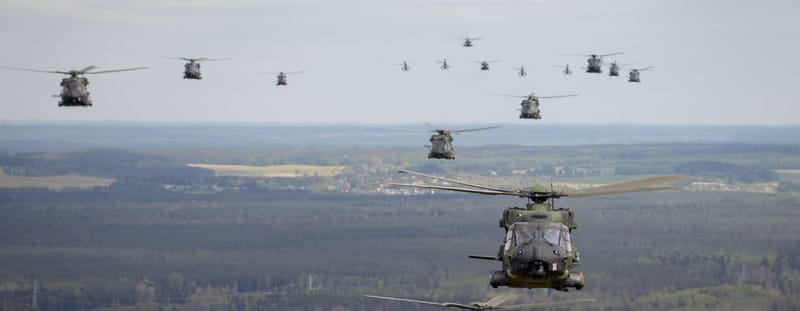From Zeitenwende to Capability: Turning the 2025 Peace Report into a European Defense Plan
Großwald translates the Friedensgutachten 2025 into a 36-month roadmap for missile defense, strike doctrine, cyber deterrence, and industrial integration.
Executive Summary
Each year, leading German peace- and security-research institutes— IFSH, PRIF, BICC, INEF and partners — publish the Friedensgutachten (Peace Report), a joint policy assessment submitted to the Federal Government and Bundestag. For practitioners in defence, diplomacy, and development, it has become a standing point of reference.
This commentary builds directly on the 2025 edition, whose core warning — “Europe must become militarily self-reliant” — sets the stage for Großwald’s proposed 36-month capability roadmap. We translate these strategic signals into concrete priorities across missile defence, long-range strike, cyber deterrence, defence-industrial integration, and strategic enablers. Where appropriate, our recommendations align directly with the Report’s own proposals (e.g., §3 “Rüstungsdynamiken”, Rec. 1, 7, 10).
Purpose & stance. This is Großwald’s independent operational reading of the Peace Report — shared in a spirit of constructive dialogue. It does not seek to reinterpret the normative foundation of the Friedensgutachten, but rather to extend its strategic signals into a defense-planning context by bridging peace-research insight with field-level doctrine, procurement, and capability planning.
Why this matters now. The Report’s second “Zeitenwende” chapter underscores three shocks: (1) a re-elected U.S. administration openly conditioning its security guarantees, (2) Russia’s new Oreschnik MRBM, and (3) China’s accelerating nuclear expansion.
Yet European NATO members, while spending €480 billion+ a year — already more than Russia even after PPP adjustment — still deliver only partial capability because programmes are fragmented and procurement opaque.
Bottom line. Friedensgutachten 2025 diagnoses the strategic moment; this brief supplies the budgets, milestones, and doctrine needed to turn rhetorical Zeitenwende into fielded capability.
Doctrinal Preview │ Five Fault Lines
The following index reflects Großwald’s interpretation of how the Friedensgutachten 2025’s strategic assumptions translate into concrete operational imperatives for European defense planners:
1 | Missile defense beyond symbolism. Arrow 3’s purchase plugs only the exo-atmospheric slice of the threat envelope. A credible shield requires a layered stack (IRIS-T SLM | Patriot | THAAD/Arrow 2 | Arrow 3 | Arrow 4) — all tightly fused into NATO’s sensor grid and governed by doctrine for MIRV/decoy saturation.
2 | Strategic autonomy as a gradient, not a slogan. Europe’s first mile of autonomy is enablers — ISR, logistics, industrial depth — not political communiqués. Without an integrated space-ISR cell, EU-based logistics corridors, and a stronger conventional backbone to underpin Franco-British nuclear guarantees, autonomy remains aspirational.
3 | Long-range strike needs rules, not just range. Stationing U.S. JASSM-ERs in Germany adds reach but also escalation fog. Shared targeting rules, a NATO-EU strike doctrine, and clearly sign-posted thresholds are prerequisites for credible deterrence.
4 | Defense industry: spend once, fight once. Europe’s €30+ billion per year in parallel tank, fighter, and UAV lines can be pared by harmonized requirements (e.g., a “2-3-4 rule”: ≥2 nations, ≤3 variants, ≥4-year linked funding) plus binding EU-level financing with IP safeguards.
5 | Cyber: from passive alarm to active deterrence. Offensive know-how must move from boutique national teams to an EU Offensive-Cyber Coordination Cell under a common legal wrapper, feeding real-time threat intel back to defenders and meshing with kinetic plans.
Priority Matrix 2025-2028 │ Großwald view
The following matrix distills these five doctrinal gaps into concrete priorities by impact, feasibility, and urgency.
| Capability | Impact | Feasibility | Why now |
|---|---|---|---|
| Layered BMD (incl. THAAD) | ★★★★★ | ★★★☆ | Oreschnik already flight-tested |
| Integrated ISR & Logistics | ★★★★☆ | ★★★★☆ | Assets exist—needs governance |
| Offensive-Cyber Doctrine | ★★★★☆ | ★★☆☆☆ | Legal lift but low CAPEX |
| Defence-Industrial Integration | ★★★☆☆ | ★★★☆☆ | Requires EU vote—saves billions |
| Long-Range Strike Doctrine Methodology by Großwald | grosswald.org | ★★☆☆☆ | ★★☆☆☆ | Politically sensitive, modest cost |
★★★★★ = critical or immediately actionable │ ★☆☆☆☆ = marginal or long-term
Impact = deterrence / autonomy value │ Feasibility = delivery complexity │ Why now = active trigger
Abbreviations: BMD = ballistic-missile defence │ ISR = intelligence, surveillance, reconnaissance │ THAAD = Terminal High-Altitude Area Defense │ CAPEX = capital expenditure
Each of the above categories represents both a strategic deficiency and a window of opportunity. What follows is the full operational unpacking of those five areas, aligned to the execution logic of Großwald’s 36-month capability roadmap.
1. Missile Defense: From Political Signal to Operational Architecture
Peace Report Insight. The report emphasizes the importance of Arrow 3 as a response to Russia’s expanding missile threats and flags the urgent need for a mid-course layer such as THAAD or Arrow 2; Arrow 4 is noted as a future requirement.
Großwald Perspective. Arrow 3 engages only at exo-atmospheric altitudes (above ≈100 km) and thus covers a narrow intercept band. To serve as more than a symbolic spearhead, it must sit within a multilayered NATO missile-defense architecture similar to Israel's proven multi-tier approach (Iron Dome-David’s Sling-Arrow 2-Arrow 3). Großwald recommends immediate, parallel procurement of THAAD or Arrow 2 to operationally close the critical mid-altitude intercept gap, leveraging existing NATO frameworks (NATINAMDS).
A credible shield therefore requires an urgent mid-altitude fill — while a next-generation exo-atmospheric tier is already in motion:
- Immediate mid-layer. Fast-track THAAD or Arrow 2 to close the altitude gap between Patriot PAC-3 MSE and Arrow 3. All tiers—including IRIS-T SLM—must be fused into NATINAMDS C2 and sensor networks for real-time cueing.
- Arrow 4 on track. Confirmed as a Luftwaffe requirement by Lt-Gen Lutz Kohlhaus (7 May 2025). Under Germany’s CPM-nov. process, the system would reach Preliminary Design Review (PDR) by late 2026, with a go/no-go budget line expected in the 2027 federal defense plan.
Operational Priorities and Timeline:
- Define and implement a European layered defense architecture (IRIS-T SLM, Patriot, THAAD / Arrow 2, Arrow 3, Arrow 4).
→ Q4 2025: NATO-level interoperability exercise
→ Q2 2026: IOC for THAAD/Arrow 2
→ Q3 2026: PDR for Arrow 4 - Secure full NATO integration for real-time sensor fusion and layered cueing.
- Develop doctrine for multi-vector saturation scenarios (MIRVs, decoys, glide-phase threats).
- Curated No. 20: F-126 delays, Taurus readiness issues, Arrow-3 debates, and NATO layered defense gaps.
- Curated No. 19: Bundeswehr confirms Arrow-4 as next-layer requirement above Arrow-3.
2. Strategic Autonomy: From Political Vision to Enabling Capabilities
Peace Report Insight: Strategic autonomy is no longer optional as U.S. guarantees erode. Calls for strategic autonomy are well-placed, particularly under the assumption of sustained U.S. disengagement.
Großwald Perspective: Strategic autonomy must pivot immediately towards practical, measurable capabilities rather than aspirational declarations. Specifically, Großwald advocates a structured EU-wide logistics and ISR integration modeled on NATO’s "Hub-and-Spoke" logistics operations (e.g., Central European logistics hubs with pre-positioned resources in Germany, Poland, and Romania). Additionally, we propose explicit alignment of conventional European forces to bolster France’s nuclear deterrent posture via clearly defined roles and transparent integration exercises.
Operational Priorities and Timeline:
- Build interoperable ISR and battle management architectures.
→ Q3 2026: Formal EU ISR integration pilot with satellite and UAV interoperability. - Establish EU-based logistics corridors and prepositioning sites.
→ Q1 2026: Establish EU logistics operational centers in Germany and Poland. - Enhance conventional capabilities to complement national nuclear roles.
- Prepare a European verification & transparency agenda
should Washington and Moscow negotiate a post-New-START deal that sidelines alliance equities.
→ Q2 2027: Complete a comprehensive EU-NATO joint verification exercise simulating post-New-START transparency measures.
- Curated No. 18: The Readiness–Conversion Gap, with EU logistics, budget surges, and Berlin's industrial friction.
3. Long-Range Strike: Integration and Threshold Clarity
Peace Report Insight: The report examines the planned stationing of U.S. JASSM-ER missiles in Germany and the strategic ambiguity this introduces.
Großwald Perspective: Long-range strike capabilities must be paired explicitly with coherent NATO-EU doctrine to prevent escalation miscalculations. Großwald explicitly proposes establishing defined targeting rules and thresholds mirroring U.S.-South Korean alliance doctrine, clearly signaling to Russia specific conditions triggering conventional strikes. Shared command structures with dual NATO-EU accountability mechanisms must be established to reinforce credible deterrence.
Operational Priorities and Timeline:
- Establish joint NATO-EU strike doctrine for long-range precision assets.
→ Q2 2026: NATO-EU working group finalizes joint strike doctrine. - Integrate host-nation basing into multinational logistics and command structures.
→ Q4 2026: Operational readiness exercise validating dual-accountability command. - Clarify escalation thresholds for conventional deep-strike missions.
→ Q2 2027: Full operational status achieved for JASSM-ER integration with transparent escalation thresholds.
- Curated No. 20: The Berlin–London Deep Strike program (2,000 km), NATO doctrinal tension, and strategic ambiguity risks.
- Curated No. 21: JASSM-ER implications, Taurus readiness rates, and doctrinal lag.
4. Defense Industry: From Fragmentation to Functional Integration
Peace Report Insight: The report identifies the inefficiency of Europe’s fragmented defense industrial base and calls for greater integration and transparency.
Großwald Perspective: Großwald proposes a clear and enforceable framework, modeled after the A400M joint procurement but avoiding past pitfalls by implementing a "2-3-4 rule": minimum two nations per program, maximum three variants, and a minimum four-year joint funding commitment. Additionally, binding EU-level contracts with IP protections (as in the civilian Airbus model) must incentivize genuine cross-border joint ventures to practically consolidate production and reduce costs significantly.
Operational Priorities and Timeline:
- Harmonize requirements across major European procurement programs (e.g. MGCS, FCAS).
→ Q3 2025: EU Council decision on “2-3-4 rule” framework implementation. - Create binding EU-wide funding instruments with clear conditionality.
→ Q1 2026: Binding agreements signed for next-gen tank (MGCS) and UAV platforms under new framework. - Incentivize cross-border joint ventures through guaranteed orders and IP protections.
→ Q4 2026: Establish transparent EU procurement oversight mechanism with public milestone tracking.
Comparative Insight:
Großwald’s earlier analysis on EO 14267 and the Procurement Divide illustrates precisely how U.S. acquisition reforms highlight Europe's persistent procurement friction. Case studies such as MGCS delays, FCAS disputes, and the rare success of RCH-155 underscore the urgency—and feasibility—of structural reform.
- Curated No. 20: ELSA missile co-development and NSPA corruption detail.
- Curated No. 18: Europe’s fragmented procurement, Rheinmetall–Lithuania link, and production lag.
5. Cyber Operations: From Threat Recognition to Coordinated Capability
Peace Report Insight: The document notes growing cyber threats and advocates for better knowledge-sharing and offensive coordination across the EU.
Großwald Perspective: Europe requires an EU-wide Cyber Coordination Cell, distinct from national agencies such as BSI and ANSSI, which mandates unified offensive cyber operations under a clear legal umbrella. Modeled after U.S. Cyber Command’s operational integration, this cell should actively identify vulnerabilities, dismantle common attack infrastructures (e.g., international botnets), and conduct real-time intelligence sharing directly with civilian and military defenders, dramatically improving proactive deterrence capabilities.
Operational Priorities and Timeline:
- Define legal frameworks for EU-wide cyber operations, including offensive mandates.
→ Q2 2026: Legal framework established and EU directive authorizing offensive cyber mandate adopted. - Establish permanent cyber coordination cells with technical tasking authority.
→ Q4 2026: Operational activation of EU Cyber Coordination Cell with technical and legal authorities. - Link cyber intelligence with kinetic defense planning to enable multi-domain deterrence.
→ Q2 2027: Initial cyber-intelligence integration exercise feeding directly into kinetic planning scenarios.
- Curated No. 20: pro-RU DDoS activity and parcel bomb plot; links cyber, hybrid, and disinfo vectors.
- Curated No. 21: BSI cyber warnings for decentralised grid vulnerabilities and hybrid activity targeting infrastructure.
- Curated No. 19: EU tribunal trigger, CI threat escalation, and espionage tensions on NATO’s eastern flank.
Conclusion │ From Talk to Tested Capability
The Friedensgutachten 2025 perfectly frames the why. Großwald offers a perspective on the how—translating strategic intent into executable direction. Europe’s Zeitenwende cannot remain rhetorical; it must become real through interoperable systems, enforceable coordination, and doctrine tested under pressure.
What’s needed now: integrated sensors, binding contracts, practiced responses, and a 36-month implementation clock—ticking toward the 2027 NATO Summit. Transparent procurement oversight and visible “social offsets” will also be vital to shield the program from political blow-back.
The second Zeitenwende will be measured in capability, not communiqué. And the window for credible delivery is narrowing fast.
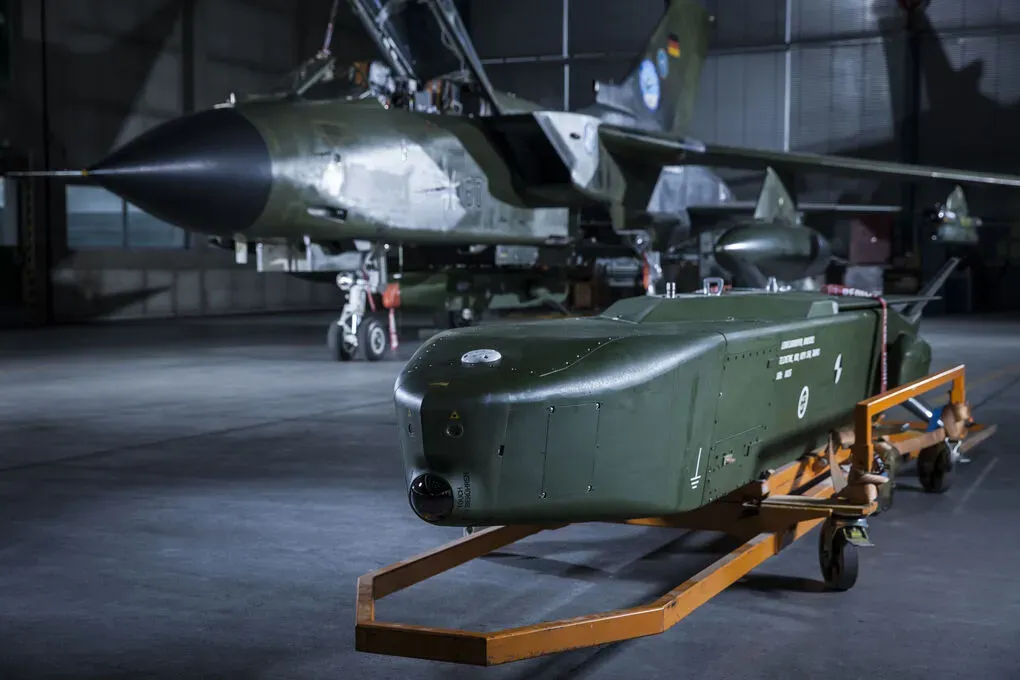
Editorial Note (Updated June 4, 2025): This article was refined to include a structured 36-month capability roadmap and expanded milestone detail across all five operational domains. Minor updates reflect new Bundeswehr planning for Arrow 4 and clarify cyber integration timelines. The core analysis and strategic argument remain unchanged.
About Großwald
Großwald delivers structured intelligence on Europe’s defense architecture—tracking procurement flows, posture shifts, and platform integration across NATO’s eastern front, Germany’s industrial core, and the evolving security perimeter.
We focus on the intersection of military modernization, strategic doctrine, and advanced defense technologies—serving professionals in defense, policy, and industry. Großwald operates as an independent research and editorial platform. Our work is unaffiliated with any government, defense contractor, or sponsor.
From Berlin’s doctrine to the Baltic frontier—Großwald maps the structure of European defense.
